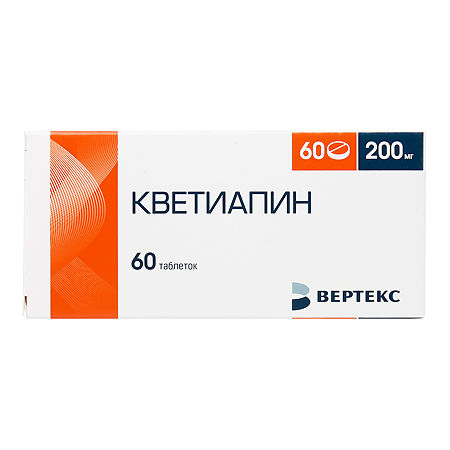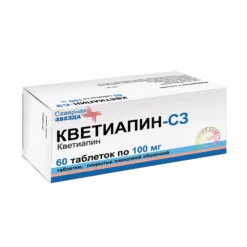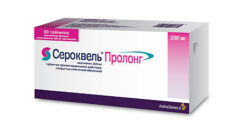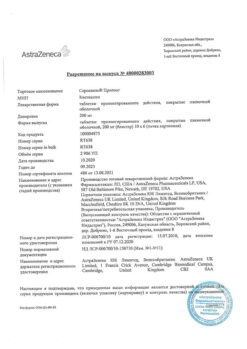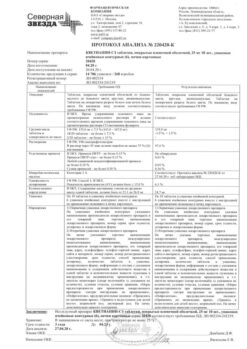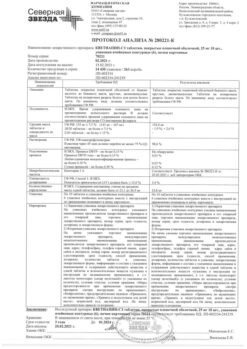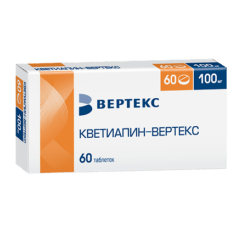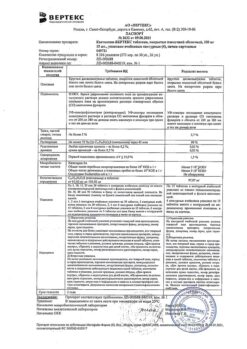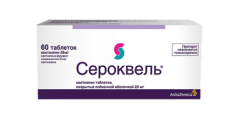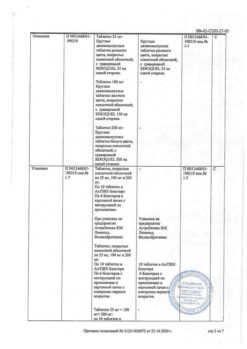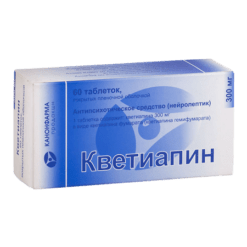No products in the cart.
Quetiapine, 200 mg 60 pcs
€1.00
Out of stock
(E-mail when Stock is available)
Description
Pharmacodynamics
Quetiapine is an antipsychotic (neuroleptic). It has a higher affinity for serotonin receptors (5-HT2) than for dopamine D1 and D2 receptors in the brain. It has tropism to histamine and alpha1-adrenoceptors and is less active towards alpha2-adrenoceptors. No selective affinity to m-choline and benzodiazepine receptors was found.
Decreases the activity of mesolimbic A10-dopaminergic neurons compared to A9-nigrostriate neurons involved in motor functions. Does not cause a prolonged increase in prolactin concentration. The duration of binding to 5-HT2-serotonin and D2-dopamine receptors is less than 12 hours.
Pharmacokinetics
Absorption is high, food intake does not affect bioavailability. Binding with plasma proteins – 83%. It is actively metabolized in the liver with the formation of pharmacologically inactive metabolites under the influence of CYP3A4 isoenzyme, mediated by cytochrome P450.
Quetiapine and some of its metabolites have weak inhibitory effects on the CYP1A2, CYP2C9, CYP2C19, CYP2D6 and CYP3A4 cytochrome isoenzymes, but only at concentrations 10-50 times greater than those occurring at the commonly used dose of 300-450 mg/day.
Extracted by the kidneys – 73%, through the intestines – 21%. The elimination half-life is 7 hours. Average clearance in elderly patients is 30-50% less than that observed in patients aged 18 to 65 years. In renal and hepatic insufficiency clearance decreases by 25%.
Indications
Indications
Acute and chronic psychosis (including schizophrenia); manic episodes in the structure of bipolar disorder.
Active ingredient
Active ingredient
Composition
Composition
1 film-coated tablet contains:
the active ingredients:
quetiapine fumarate (quetiapine hemifumarate), in terms of quetiapine 200 mg;
auxiliary substances:
Hyprolose (Clucel LF hydroxypropylcellulose),
calcium hydrophosphate dihydrate,
Pregelatinized starch,
magnesium stearate,
sodium carboxymethyl starch (sodium starch glycolate; primogel),
cellulose microcrystalline;
composition of the film coating:
AquaPolish D 8107 [hypromellose (hydroxypropyl methyl cellulose), glycerol (glycerol),microcrystalline cellulose,talc, candurin silver luster dye ([potassium aluminosilicate E555, titanium dioxide E171]), indigo carmine dye aluminum varnish].
How to take, the dosage
How to take, the dosage
Treatment of acute and chronic psychosis, including schizophrenia.
The daily dose for the first 4 days of therapy is 50 mg (day 1), 100 mg (day 2), 200 mg (day 3), 300 mg (day 4). Starting on day 4, the dose should be titrated to effective, ranging from 300 to 450 mg/day, up to 750 mg/day if necessary.
Treatment of manic episodes in the structure of bipolar disorder.
Quetiapine is used as monotherapy or as adjuvant therapy to stabilize mood.
The daily dose for the first 4 days of therapy is 100 mg (day 1), 200 mg (day 2), 300 mg (day 3), 400 mg (day 4). Further, by the 6th day of therapy, the daily dose of the drug can be increased to 800 mg. Increase in the daily dose should not exceed 200 mg per day.
Depending on clinical effect and individual tolerance, the dose may vary from 200 to 800 mg/day. Usually the effective dose is 400 to 800 mg/day.
For treatment of schizophrenia, the maximum recommended daily dose of quetiapine is 750 mg; for treatment of manic episodes in the structure of bipolar disorder, the maximum recommended daily dose of quetiapine is 800 mg/day.
In renal and/or hepatic impairment and in elderly patients, the initial dose is 25 mg/day, with daily increases of 25-50 mg thereafter until an effective dose is achieved.
Interaction
Interaction
In concomitant administration of drugs with strong inhibitory effect on CYP3A4 (such as azole antifungals and macrolide antibiotics), plasma concentration of quetiapine may increase.
In such cases, lower doses of vetiapine should be used. Particular attention should be paid to elderly and frail patients. The risk-benefit ratio for each patient must be evaluated individually.
Inducers of microsomal liver systems (phenytoin et al.), thioridazine increase clearance of quetiapine, inhibitors of microsomal liver systems decrease it; at the same time simultaneous administration of quetiapine and antidepressants – imipramine (CYP2D6 inhibitor) or fluoxetine (CYP3A4 and CYP2D6 inhibitor) has no significant effect on its pharmacokinetics.
The pharmacokinetics of quetiapine is not significantly altered when prescribed concomitantly with the antipsychotic drugs risperidone or haloperidol.
Does not cause induction of liver enzyme systems involved in antipyrine metabolism.
Pharmacokinetics of lithium preparations are not altered by concomitant administration of quetiapine.
No clinically significant changes in the pharmacokinetics of valproic acid and quetiapine have been noted when divalproex sodium (sodium valproate and valproic acid in a molar ratio of 1:1) and Quetiapine are co-administered.
Drugs that depress the central nervous system and ethanol increase the risk of side effects.
Special Instructions
Special Instructions
No correlation between quetiapine administration and QTc interval prolongation has been found. However, caution should be exercised when using vetiapine concomitantly with drugs that prolong the QTc interval.
In children, adolescents and young adults (younger than 24 years) with depression, other psychiatric disorders, antidepressants, compared with placebo, increase the risk of suicidal thoughts and suicidal behavior. Therefore, when prescribing antidepressants in children, adolescents, and young adults (younger than 24 years), the risk of suicide and the benefits of their use should be weighed.
In short-term studies, people over the age of 24 had no increased risk of suicide, and people over the age of 65 had a slightly decreased risk of suicide. Any depressive disorder itself increases the risk of suicide. Therefore, all patients should be monitored during antidepressant treatment for early detection of impairment or behavioral changes as well as suicidal tendencies.
During treatment, caution should be exercised when driving motor vehicles and engaging in other potentially hazardous activities that require increased concentration and rapid psychomotor reactions.
Contraindications
Contraindications
Hypersensitivity to any of the ingredients of the drug.
With caution: Arterial hypotension, epilepsy and epileptic seizures (history).
Side effects
Side effects
Nervous system disorders: drowsiness, dizziness, headache, anxiety, asthenia, hostility, agitation, insomnia, akathisia, tremor, convulsions, depression, paresthesias, malignant neuroleptic syndrome (hyperthermia, muscle rigidity, altered mental status, lability of autonomic nervous system, increased creatine phosphokinase activity).
Cardiovascular system disorders: orthostatic hypotension (accompanied with dizziness), tachycardia, syncope, prolongation of QT interval (no relationship of quetiapine use with continuous increase of QTc was found).
Digestive system disorders: dry mouth, nausea, vomiting, abdominal pain, diarrhea or constipation, increased liver transaminase activity.
Respiratory system: pharyngitis, rhinitis.
Allergic reactions: skin rash, eosinophilia.
Laboratory parameters: leukopenia, hypercholesterolemia, hypertriglyceridemia, decreased concentration of thyroxine (the first 4 weeks).
Other: low back pain, chest pain, subfebrile, weight gain (mainly in the first weeks of treatment), myalgia, dry skin, visual impairment.
Similarities
Similarities
Additional information
| Shelf life | 2 years. |
|---|---|
| Conditions of storage | In a dry, light-protected place at a temperature not exceeding 25 ° C. |
| Manufacturer | Vertex, Russia |
| Medication form | pills |
| Brand | Vertex |
Other forms…
Related products
Buy Quetiapine, 200 mg 60 pcs with delivery to USA, UK, Europe and over 120 other countries.

